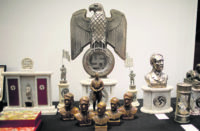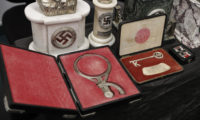 The Nazi objects seized from a shady dealer/collector in Buenos Aires in 2017 have been officially deposited at the Holocaust Museum of Buenos Aires. The 83 objects — 71 unique pieces and some duplicates — were found during a raid seeking trafficked Chinese antiquities. Secreted in full Nancy Drew style behind a bookcase, Argentine Federal Police agents found a hidden room filled with Nazi artifacts including an eagle statue on a swastika base, an SS hourglass, a large bust of Hitler, a bunch of small busts of Hitler, a cranial measurement device used to determine ostensible racial purity, a sphinx figurine that’s serving heavy Raiders of the Lost Arc vibes, and a Ouija board inscribed with Nazi symbols, an example of Nazism’s obsession with the occult.
The Nazi objects seized from a shady dealer/collector in Buenos Aires in 2017 have been officially deposited at the Holocaust Museum of Buenos Aires. The 83 objects — 71 unique pieces and some duplicates — were found during a raid seeking trafficked Chinese antiquities. Secreted in full Nancy Drew style behind a bookcase, Argentine Federal Police agents found a hidden room filled with Nazi artifacts including an eagle statue on a swastika base, an SS hourglass, a large bust of Hitler, a bunch of small busts of Hitler, a cranial measurement device used to determine ostensible racial purity, a sphinx figurine that’s serving heavy Raiders of the Lost Arc vibes, and a Ouija board inscribed with Nazi symbols, an example of Nazism’s obsession with the occult.
At the time of the bust, the name of the collector was not released. We now know it was Carlos Alberto Oliveras. He was charged with violating cultural heritage protection laws regarding other objects found in the raid. In Argentina it’s not a crime to have a bunch of tacky gross Nazi junk in your house. It’s only a crime to sell it, and only original material, so the first step to determining whether Oliveras’ creepy secret Nazi stash was in violation of the law was to determine its authenticity.
 Experts from Argentina and Germany have now thoroughly examined and researched the collection. Most of the objects are indeed authentic produced during the Nazi period in Germany and German-occupied countries. Some were modified to make them more colorful and appealing to buyers, others are later replicas. Oliveras will be tried for keeping Nazi artifacts for commercial purposes (he denies the charge) and the collection has been deposited at the museum by judicial order.
Experts from Argentina and Germany have now thoroughly examined and researched the collection. Most of the objects are indeed authentic produced during the Nazi period in Germany and German-occupied countries. Some were modified to make them more colorful and appealing to buyers, others are later replicas. Oliveras will be tried for keeping Nazi artifacts for commercial purposes (he denies the charge) and the collection has been deposited at the museum by judicial order.
As many as 5,000 Nazi officials are believed to have fled to Argentina after the war, including monsters in human form like Josef Mengele and Adolf Eichmann. The quality and rarity of some of the objects suggests they may have belonged to high-ranking Nazis.
Museum President Marcelo Mindlin said at a press conference on Wednesday that with the judicial deposit:
“they ceased to be objects of a clandestine Nazi cult market to be at the service of education and memory. These despicable objects come from an ideology that produced torture and death. They are the sign of a regime of hate and discrimination that ended the lives of eleven million people (including 1.5 million children), and dragged the world into the worst moment in its history. These objects, which were used in the past to foster hatred, death and destruction, will now be at the service of the transmission of democratic values, education and the struggle for memory, so that tragedies, such as that of the Holocaust, do not happen again.”
The Holocaust Museum of Buenos Aires, the only Holocaust museum in Latin America, opened in 2001. It has been closed for two years of remodeling and conservation work and is scheduled to reopen on December 1st. The objects will be exhibited in its collection of Nazi propaganda and paraphernalia.